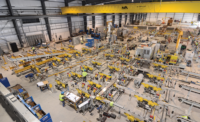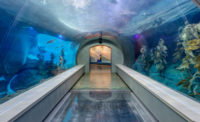No doubt, growth through acquisition has proven a successful tactic for DLZ Corp., says chairman and chief executive officer Vikram “Raj” Rajadhyaksha. But the act of buying another firm alone won’t truly grow or even sustain a business; it’s about culture, he says.
It’s a message Raj’s sons Shyam and Ram Rajadhyaksha have heard loud and clear. “When you buy a firm, what you’re really buying is those relationships long developed and nurtured by the people in that firm,” says Shyam, DLZ’s vice president and corporate secretary, “and if those key people leave, then those relationships go. You really want to make sure that you create an environment where people want to stay.”
With the majority of the firm’s dozen or so acquisitions dating back to 1984, a common theme has been the desire of the outgoing owner to “willfully retire,” says Ram, also a DLZ vice president, who has guided and implemented recent key corporate additions in Michigan and Illinois.
“Our acquisition strategy has been successful because we don’t come in and blow the organization up,” he says. “We really spend time to understand the employees and build that environment in which they think their best interests are to stay.”
It seems to have worked. One of the acquisitions, Chas. W. Cole and Son, which dates back to 1916— and presents DLZ with the opportunity to celebrate 100 years of business—was bought in 1991. Joseph Zwierzynski was a structural engineer with the stalwart South Bend, Ind.-based firm back then; today, he is chief operating officer for DLZ, yet 25 years later he is still based in northwest Indiana at one of DLZ’s 20 offices. “We promote from within,” explains patriarch Raj. “I’m not very fond of hiring from the outside for senior executive positions.”
Among the largest minority-owned design firms in the U.S., Columbus, Ohio-based DLZ has become a perennial top 10 among ENR Midwest Top Design Firms, topped only by national and international firms doing business in the Midwest. In the new rankings based on 2015 design revenue, the firm is ranked the second largest in Indiana, eighth in Ohio and, at $91.2 million, ninth overall in the region. Of the company’s global design revenue, a whopping 88.3% came from the six states officially comprising ENR’s Midwest region. DLZ, says Raj, remains a regional company; it may think globally, including related ventures in his native India, but acts locally first and foremost.
Recent notable and award-winning projects include the Main Street Bridge in Columbus; the Interstate 75 interchange in Gaylord, Mich.; the Martin Luther King Jr. Bridge in Fort Wayne, Ind.; the $350-million OARS Deep Sewer Tunnel in Columbus; and, the firm’s largest project to break ground in 2015, the $184-million Akron CSO Ohio Canal Interceptor Tunnel in northeast Ohio.
How DLZ Came to Be
The initials in the DLZ brand harken back to homegrown Columbus engineering firm Dodson-Lindblom Associates Inc., originally A.M. Kinney, and then Dodson, Kinney and Lindblom.
An evening walk one night in 1978 led Raj into business for himself; he stopped to extend condolences to neighbor and Dodson-Lindblom junior partner Al Strange on the recent passing of Dodson. Raj, who had been in the Columbus market for 10 years and by then was the state of Ohio’s head of dam safety, learned the firm had shrunk to about a half-dozen employees and offered his assistance to Strange. “He said, ‘What can you do?’ I said, ‘Well, I can dig up work. I know everybody at the Army Corps of Engineers and I know everybody at the state.’ ”
Furthermore, Raj pointed out to his Worthington neighbor, his ownership would qualify the firm as minority-owned and would enhance opportunities as a subsequent participant in the Small Business Administration’s Section 8(a) Business Development Program. “That’s all they needed to hear. So, I got in as president. I owned 52% from Day 1 and I paid cash from my retirement fund from the state of Ohio. So, right then and there, I got into business and we haven’t looked back since then,” he says. “Our work with the Corps continued because they liked our work. Even with the 8(a) program, in all fairness, if you don’t do good work, you’ll get one job and they are not going to put up with nonsense. It was definitely a big help for a fledgling engineering company to get its feet beneath it, but then we did OK work.”
Dodson and Lindblom already had a good relationship with the Corps, and Raj’s background in dam safety proved a perfect fit. “We also got very fortunate,” he admits. “During President Carter’s tenure, he started the National Dam Safety Program, and, all of a sudden, he gave the responsibility for dams to the Corps of Engineers. The Corps locally found me to be a godsend because I had done all this work prior with the state. Instantly, we had more work than we knew what the hell we could do with. We did about 300 dam safety inspections in this region. It was just one contract after another, and it went on for three or four years.”
Equally important, says Raj, Strange remained with what is now DLZ for some time after the purchase, proving to be the first of many such amiable acquisition relationships to be nurtured over the following two generations. One of the meeting rooms in the company’s newly renovated head office in north Columbus today bears the Strange name.
As companies were added, they would be incorporated as DLA, DLB, etc., with DLZ as the holding company. DLZ is now the public brand.
Moving Right Along
“In 1984, I started my acquisition program,” says Raj, noting that the firm was quickly growing too big for the 8(a) program. “I knew this gravy train that I was on was not going to last. To compete with the rest of the world, we had to have skills and, wherever we didn’t have the skills, I decided I was going to add them by acquiring companies.”
The first addition was Mason-Deverteuil, a Columbus geotechnical firm housed on property adjacent to the current DLZ corporate office. That was followed in 1987 by the acquisition of what was then the largest engineering firm in Ohio, A.E. Stilson & Associates, founded by Gen. Alden E. Stilson. “I had known the general when I first came into town,” says Raj. “He was the president of the American Society of Civil Engineers locally, and he welcomed me into the society, for which I was very grateful.” Stilson specialized in highway work, which Dodson-Lindblom did not. “Again, I have followed my principle that if I am going to get into it, I am going to do it my way. I’m going to buy control,” says Raj. “An old boss told me that partnerships are like marriages without the joy of sex. If I’m going to put my money in, I’m going to call the shots.”
A 50-employee company bought one with 200 employees, “and other than the chairman, we didn’t fire anybody,” says Raj. “That has been our hallmark in all acquisitions. I don’t go in there and fire everybody.” More acquisitions followed in quick succession, including the monumental 1991 purchase of Cole. “By this time, I was getting a reputation of being able to acquire troubled engineering companies and turn them around without too much bloodshed, which is firing half the staff.”
The fit has to be right, though, says Zwierzynski. “We don’t buy every small firm,” he says. “There’s some chemistry that needs to happen, and we’ve walked away from some deals that just didn’t feel right.”
While keeping its offices local, DLZ has adopted a “one-company approach” to business that avoids silos. “We are a better business now,” says Ram. “We are out of the recession, the economy is growing, and we’re running a better practice now.” Adds Shyam: “All employees market for DLZ. We don’t use profit as a bad word—we realize we need profit in order to grow the company—but another key component is compassion, which I think is what attracts people to our company. A lot of owners don’t want to be acquired by a megafirm. They have a small-firm mentality and they want to keep that mentality, and that’s one thing we do.”
With his 70th birthday decorations still up on the wall behind him, Raj Rajadhyaksha isn’t about to rest on a long career that started when a university in the U.S. Midwest gave a chance to a curious kid from India. “We’re still growing, which is the truly important part,” he says. “Our backlog this year is higher than it has ever been, which is a definite indication that this year is doing better than last … and I’m still kicking.”











Post a comment to this article
Report Abusive Comment